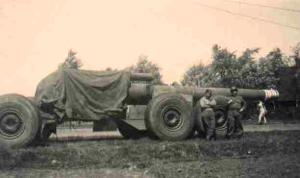
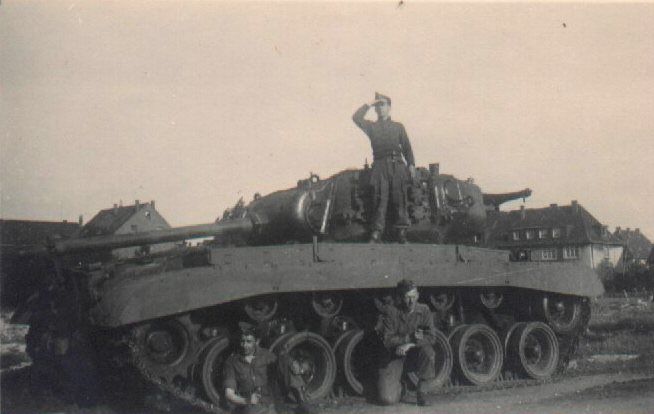
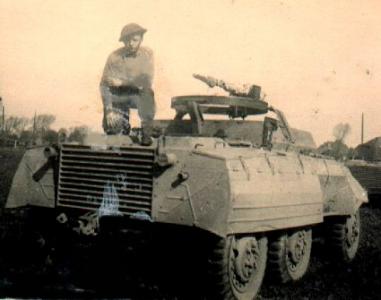
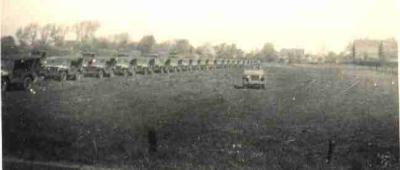
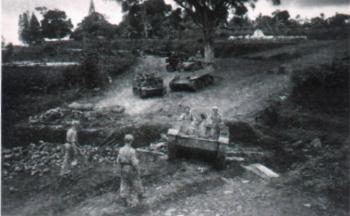

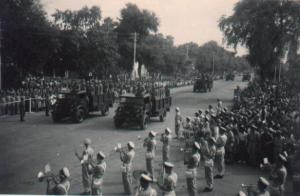
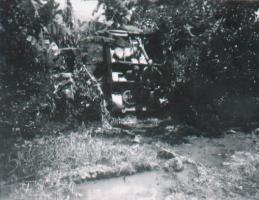
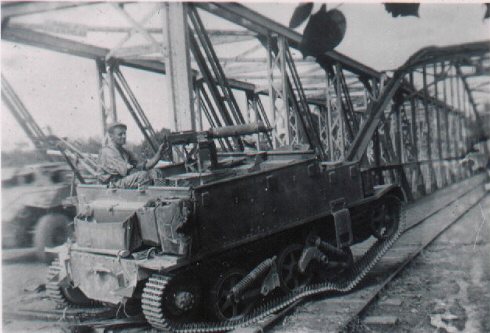
Brengun carrier with
Vickers heavy machinegun
Guarding the bridge
The battalion is getting brengun carriers. These vehicles are known as the ugliest vehicles in the army.
The constant patrolling and ambushes are finally showing results, and the harassement inside the city has virtually stopped.
The battalion is being reorganized and a support company added, in that company will be a carrier platoon consisting of twenty carriers with four men each.
In the latest batch of replacements is a first lieutenant who will command this support company to the dismay of all old hands. Soldiers are basically very loyal, and scared of untried leadership therefore, when this man announces the candidates for carrier training, and they are all men that came with him as replacements, ignoring the old hands that had transferred to this new support company, all hell breaks loose.
I am one of the leaders of this silent mutiny, and when I am given a chance to speak to the commander, I am told in no uncertain ways to mind my own business, because he will choose whom he will. This is language that is not very appreciated in an outfit that found its origin in the underground resistence. However, when the bypassed men all put in a written protest that has to be submitted to a higher authority things change in a hurry, but the damage has been done. This man has lost all respect from his troops which will never be restored, even if he later proves his personal courage.
A number of carrier instructors have arrived from Holland and a pleasant and fruitful time arrives.
We are grouped in teams of four men plus an instructor, and as we pick up our carrier at the dock the lessons begin. One student does the driving, while the other three men go along for the ride and do the criticizing. The sergeant instructor is a pleasant man that soon becomes a friend. The carrier, that is really a hybrid between a truck and a tracked vehicle, is at first hard to master but all the men are eager to learn and soon become competent drivers. The evenings are spent learning mechanical theory and tactics.
After graduation the field exercises begin and soon we are all able to get the most out of this box-on-tracks, which is going to prove very helpful for the troops as well as very dangerous for their crew. The helpfulness lies in the fact that they can go where no other vehicle can and thus is a great support for the infantry. The danger is only revealed later when the enemy learns to use landmines. The design of the carriers is such that a mine, when hit, will explode right under the driver or the commander with deadly result. Most of my buddies that got killed were killed that way. We soon learn to sit on filled sand bags, and curse the mine-clearing unt for missing one.
Coming through the training, I am picked with a number of my classmates to go to the dock, pick up brand-new carriers and put approximately 200 miles on them, supposedly driving in convoy. Detesting convoy driving, my buddy and I soon find a way out. The fuel pump of the engine has a membrane held by a number of screws, loosen some of the screws, and when the engine gets hot, false air is drawn into the fuel line. When the engine starts to sputter, fall out and declare a dirty carburetor then as soon as the convoy is out of sight, tighten the screws and on your way, avoiding the convoy for the rest of the day. When the carriers are declared in good condition we deliver them to their destination.
One of the interesting aspects of my job is visiting the many different army units. One of them is an Indonesian unit. These people are from the South Molucans, an island chain northeast of Java. For generations they have been loyal soldiers of the Dutch East Indian government and are fiercely loyal to the Dutch government. They are born in the barracks and the whole family lives together in the barracks. They are also the bodyguard of the colonel. When mealtime comes the wife of the cook helps dish out the food while the little ones play around her. The food that is served is so strongly spiced that my taste buds rebel. After valiantly trying, I finally give up on this really delicious feast and when I bring my plate with the leftover to the beggars at the gate a mother feeds it to her baby. So much for my taste buds. Another little side effect happens the next day at the latrine, when it feels like somebody is giving me an enema with a hot poker.
After I received my certificate as instructor, driver, mechanic I am sent out to train other men, that is a real cushy job but I soon work myself out of a job. Back to work, which I don't mind, as long as I can drive or command my ugly friend.
As the cavalry and his horse of old, we will have many adventures together.
Photo and story © Marinus (Mac) Traas
The brengun carriers arrived in Semarang late in 1946 and were shipped right from the factory or a supply depot, brand new. Altogether approximately 40000 were built mostly in Britain and Canada. The drivers ended up preferring the Canadian-built models because they were a little bit more agile then the others. After the war with Germany and Japan, this type of surplus material was bought by the Dutch government, and other governments rebuilding their army.
My daddy was one of those brengun carrier drivers and although Mr. Traas doesn't mention it in this story it was a very dangerous and hazardous job. Now that I know what it was like to drive the brengun carriers I understand why it was that whenever my dad was driving one and heard a boom he dove off the carrier immediately because there was no guarantee that sandbag would save him. Mr. Honnef told his daughter Petra, who told me, that whenever the group heard anything that sounded remotely like an explosion they knew that they'd find my dad a safe distance from the carrier in the usual position a soldier takes to protect himself from shrapnel. Luckily for me my daddy was never a casualty of the land mines. If you want to learn more about the brengun carriers and what traps were laid for them go to Peter van Roomen's page.